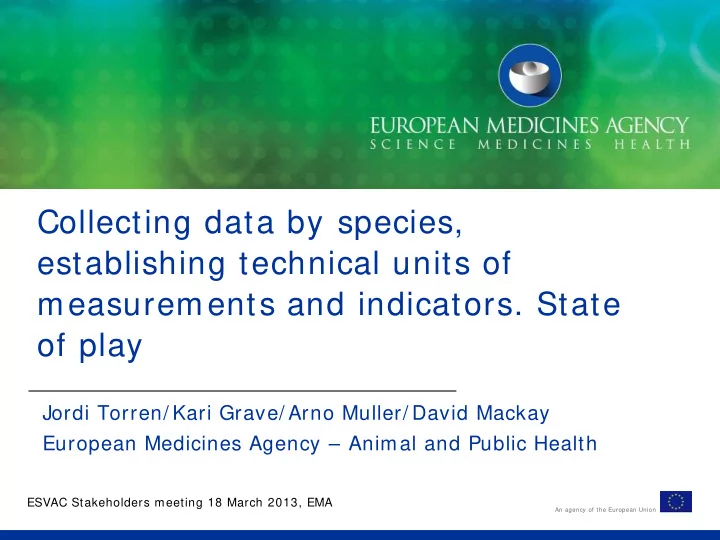

Collecting data by species, establishing technical units of measurements and indicators. State of play Jordi Torren/ Kari Grave/ Arno Muller/ David Mackay European Medicines Agency – Animal and Public Health ESVAC Stakeholders meeting 18 March 2013, EMA An agency of the European Union
Data on consumption of antimicrobial agents per animal species, technical units of measurement and indicators As a 1 st step reflection paper developed Draft agreed by European Surveillance of 30 November 2012 Veterinary Antimicrobial Consumption (ESVAC) drafting group Release for consultation 18 December 2012 End of consultation (deadline for comments) 15 March 2013 Drafting group: Jeroen Dewulf (rapporteur), Gérard Moulin (rapporteur), Boudewijn Catry, Claire Chauvin, Christina Greko, Dick Heederik, Erik Jacobsen, Inge van Geijlswijk, Scott McEwen, Cedric Muentener and Irene Litleskare 2
Animal species suggested to be prioritized Table 4. Animal species and age groups/ production category most relevant for surveillance of consumption of veterinary antimicrobial agents Species Age group/ Production category Proposed reference weights at treatment for the age group 1 Pigs Piglets 2 kg Weaners 7 kg Sows/ boars 220 kg Finishers 35 kg Cattle Veal calves 170 kg Dairy cattle 500 kg Meat cattle (beef) 500 kg Poultry Broilers 1 kg Turkeys 10 kg 1 Proposed weights might change after the public consultation period . 3
Antimicrobial groups to be included Table 5. Groups of veterinary antimicrobial agents to be included in the surveillance by animal species as applicable (ATCvet = Anatomical, therapeutic and chemical veterinary classification) Groups of antim icrobial agents ATCvet codes Antimicrobial agents for intestinal use QA07AA; QA07AB Antimicrobial agents for intrauterine use QG01AA; QG01AE; QG01BA; QG01BE; QG51AA; QG51AG Antimicrobial agents for systemic use QJ01 Antimicrobial agents for intramammary use QJ51 Antimicrobial agents used as antiparasitic QP51AG agents 4
Methods collecting data by animal species • The recommended methods are ranked in order of preference: • Continuous automated data collection including all prescriptions/ administrations/ delivery in a country. • Cross-sectional or prospective longitudinal studies in representative number of farms in order to estim ate national consumption, in tonnes of active ingredient, by species, age group and production category • Stratification by species based on overall sales data 5
Data to be provided to ESVAC • The data to be provided to the ESVAC will be the prescribed or estimated amounts consumed, in weight of active ingredient, by country and year of each product (name and pharmaceutical form or administered route) per defined animal species and age group/ production type. • These will be analysed and reported in ESVAC by use of technical units of measurement that is harmonized across EU 6
Technical units of measurement • The proposed technical units of measurement for reporting of the data in ESVAC by animal species are • Weight of active ingredient • Defined daily dose animal = DDDA • Defined course dose animal = DCDA • DDDA and DCDC should be assigned for the species suggested to be prioritised in the ESVAC project – i.e. pigs, poultry and cattle. 7
Indicators • The proposed indicators to be used for reporting of the consumption of antimicrobial agents by species the proposed indicators are: • Weight of active ingredient consumed by age group/ 1000 animals/ year. • Number of DDDA or DCDA consumed by age group/ 1000 animals/ year. 8
Suggestions for implementation • As a first step – Develop an ESVAC protocol on collection of consumption data by species by MSs – Develop an ESVAC template on data to be provided to ESVAC – Run a pilot project to test the protocol and the template in a limited number of MSs that are willing to participate and to collect and analyse these data by the ESVAC team 9
Suggestions for implementation cont • In parallel, to develop guidelines on how to assign DDDA and DCDA values for pigs, poultry and cattle across EU • To subsequently establish EU wide DDDA and DCDA values for these species 10
Responses to consultation reflection paper • Pig Veterinary Society (UK) • LEI (Wageningen University and Research centre) • National Food institute, Technological University of Denmark • Jansegers Luc (Belgium) • Veterinary Medicines Authority (SDa), Utrecht, The Netherlands • National Farmers Union of Scotland • FVE – Federation of Veterinarians of Europe 11
Responses to consultation reflection paper • Finnish Food safety Authority (Evira) and Finnish Medicines Agency (Fimea) • IFAH-Europe • IFIP - The French Institute for Pig and Pork industry • COPA-COGECA - European farmers and European Agri- cooperatives • European Group for Generic Veterinary Products (EGGVP) • Dr Juliane Bräunig, Bundesinstitut für Risikobewertung, Germany 12
Actions • The reflection paper will be revised by the drafting group and the ESVAC team. • Revised reflection paper will be published on our web pages • Overview of comments received with our considerations will also be published. 13
Recommend
More recommend